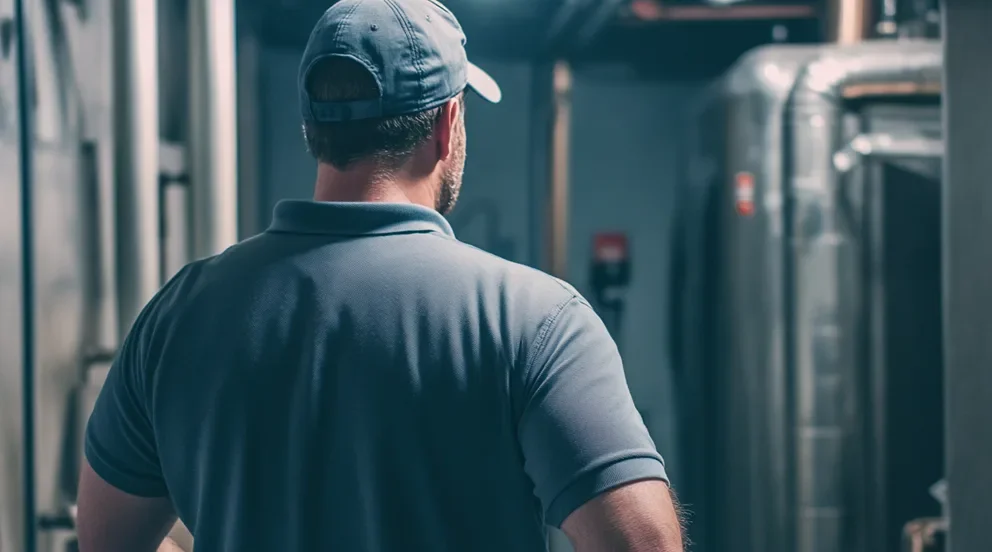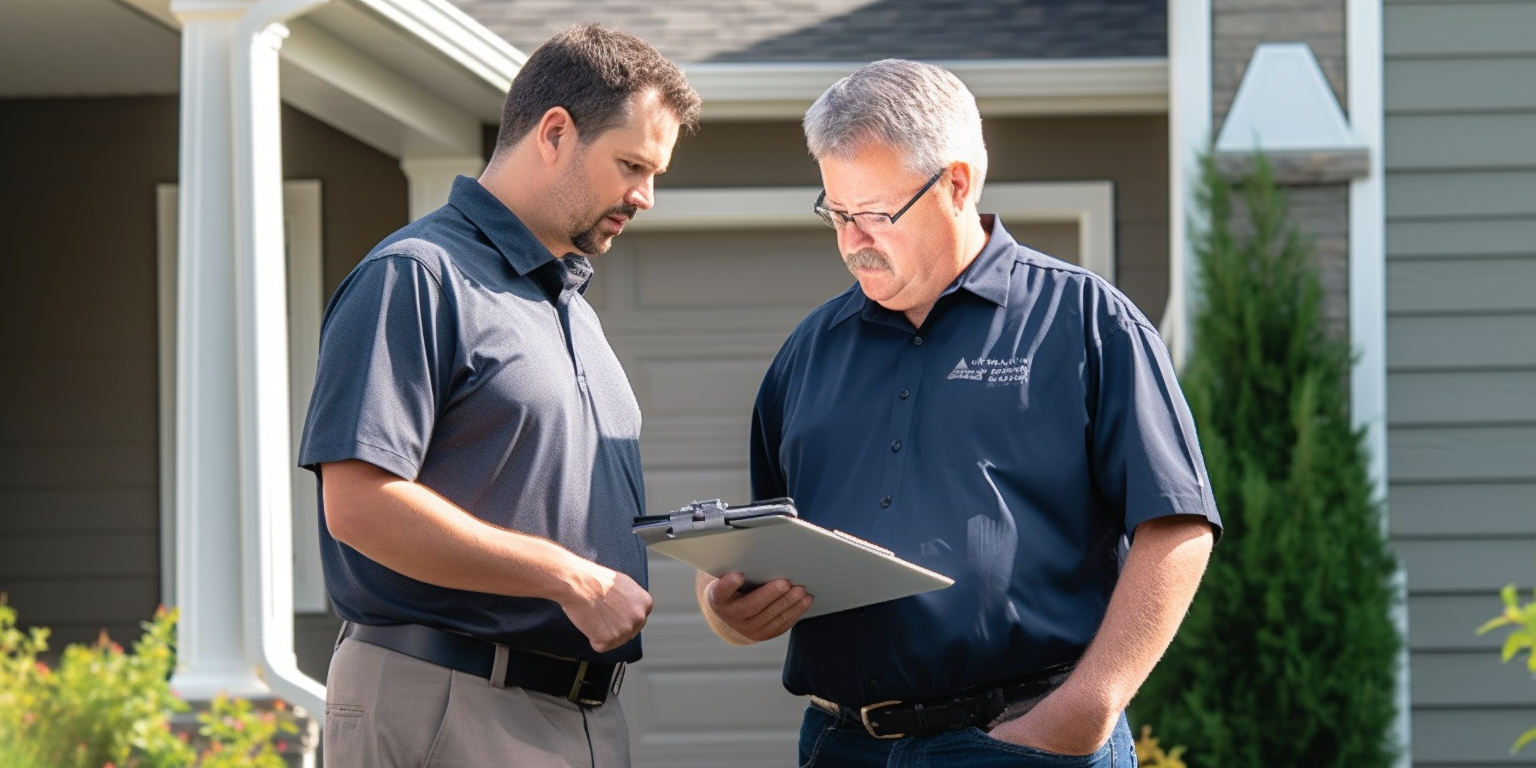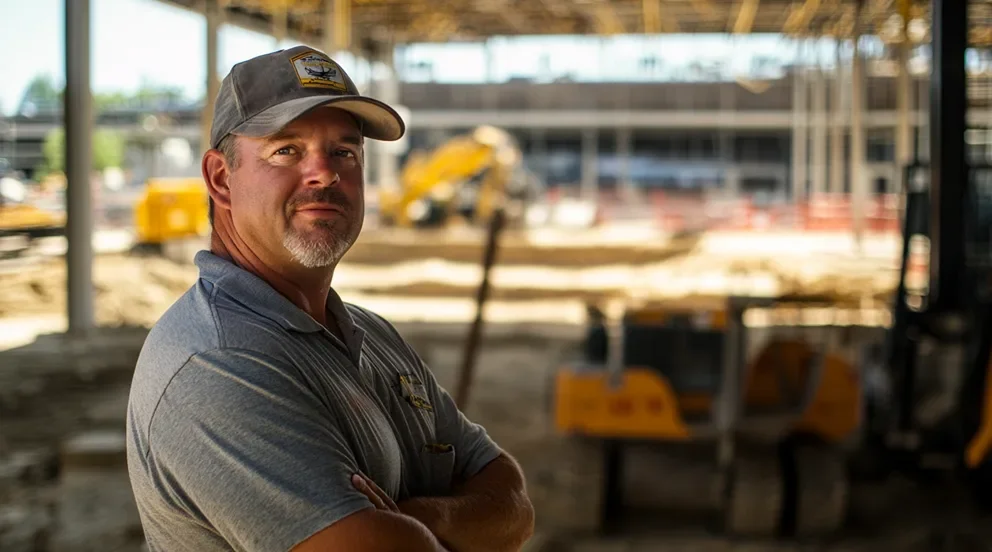Quoting a plumbing job can feel like walking a tightrope—go too high and you lose the bid, go too low and you’re working for free. And when materials, labor, and project scope shift from job to job, sticking to a flat rate won’t always cut it. Whether you're pricing out a repipe or a last-minute emergency call, your numbers have to make sense—both to your customer and your bottom line.
This one’s for the folks running the business—contractors and field managers in the plumbing industry who need a real-world system for pricing plumbing jobs that’s competitive, clear, and keeps the lights on. Let’s break down what solid plumber pricing actually looks like—and how you can build it into every quote you send.
- 7 plumbing pricing models contractors use
- What goes into an estimate when pricing plumbing jobs
- 10 steps to price plumbing work for your business
- 10 tips for fair and competitive plumbing pricing
There’s no one-size-fits-all when it comes to pricing plumbing jobs. The way you charge for a water heater install might not work for a slab leak repair. That’s why having a few go-to pricing models in your playbook can help you stay flexible without losing control. Next up, we’ll break down the most common plumbing pricing models contractors use—and when each one makes sense.
7 plumbing pricing models contractors use
When you're quoting plumbing work, the model you choose directly affects how profitable the job will be—and how smooth the customer conversation goes. Different pricing structures give you control in different situations, whether you're bidding a large install or responding to a last-minute call. Having more than one option in your back pocket keeps you ready for whatever gets thrown your way.
Here are the most common plumbing pricing models contractors rely on—and some additional ones you might not be using yet, but should consider.
Standard plumbing pricing models
- Flat rate pricing – You charge a fixed price for common jobs like toilet installs, drain cleaning, or garbage disposal swaps. It’s fast, easy to explain, and eliminates haggling.
- Project-based pricing – The customer pays one set price for the whole job. Best for larger or more defined projects like bathroom rough-ins or full repipes.
- Hourly pricing – Customers pay for time on site. Useful when you can’t predict how long the work will take—think diagnosing leaks or troubleshooting pressure issues.
- Time and materials (T&M) – You charge for hours worked and parts used. It’s flexible, especially for repair jobs where scope changes mid-stream.
- Tiered service levels – Offer different pricing packages for the same type of service. For example: basic faucet replacement vs. premium with upgraded parts and warranty.
- Subscription or membership pricing – Customers pay a recurring fee for routine maintenance or VIP treatment (like priority scheduling or waived fees). Good for long-term cash flow and customer retention.
- Value-based pricing – You price based on the perceived value to the customer. If you’re the only one offering same-day trenchless repair, charge accordingly. This model demands confidence—and market awareness.
Other plumber pricing models worth considering
- Cost-plus pricing – You total up labor, parts, travel, permits—then add your profit margin. Simple, scalable, and great for commercial or multi-day jobs.
- Dynamic pricing – Rates change based on time of day, urgency, or technician availability. Charge more for weekend calls or late-night emergencies when resources are tight.
- Geographic pricing – Adjust pricing based on service location. Urban, rural, or hard-to-reach areas can have different travel and labor costs—and your prices should reflect that.
- Bundle pricing – Offer a discount when customers book multiple services at once (e.g., drain cleaning + water heater flush). It helps drive ticket size without losing margin.
- Penetration pricing – Price low to win new customers or break into a new neighborhood. Once demand picks up, raise prices gradually to align with market value.
- Skimming pricing – Launch a new or specialty service (like water quality testing) at a premium. Then drop the price later as competitors catch up.
Expert Tip
Want to go deeper into how software tools are priced in the industry? Take a look at our full guide to plumbing software pricing for a breakdown of what you get, what it costs, and how to compare your options.
The key is flexibility. No one model works for every job or customer. The best plumbing businesses have a handful of pricing methods ready—and know exactly when to use each one.
What goes into an estimate when pricing plumbing jobs
Every estimate you send should back up your price with facts. That’s how you stay profitable without overcharging—and how you avoid awkward callbacks when the bill surprises your customer. Good estimates are clear, detailed, and account for every moving piece of the job.
Here’s what should always go into your plumbing pricing estimates:
- Time and labor – This includes the total man-hours expected and the skill level of your techs. A simple faucet swap won’t cost the same as a full gas line install.
- Parts and materials – From pipe fittings and valves to toilets and water heaters—every item used on-site should be listed and priced out clearly.
- Travel – Gas, drive time, wear and tear—it all adds up. Especially for rural jobs or multiple stops in a day.
- Equipment use – If you’re using specialty gear like leak detection tools, sewer cameras, or jetters, that cost should be factored in—especially for rental equipment.
- Emergency response – After-hours, holiday, or same-day service? That’s premium time and it should be priced accordingly.
- Unexpected project conditions – Jobs rarely go exactly as planned. Build in a buffer for things like digging through concrete, cutting drywall, or replacing rusted pipe you didn’t see at the start.
- Taxes – Don’t forget sales tax, fuel surcharges, or other local fees you’ll need to pass through to stay compliant.
- Overhead – This is where most contractors miss the mark. Building rent, utilities, insurance, software, phone lines, admin staff—it’s all part of running the shop. Roll a percentage of this into each estimate so you're not covering it out of pocket.
Bottom line: If it costs you time, money, or resources—it belongs in your estimate. Clear plumber pricing builds trust and keeps your business healthy.
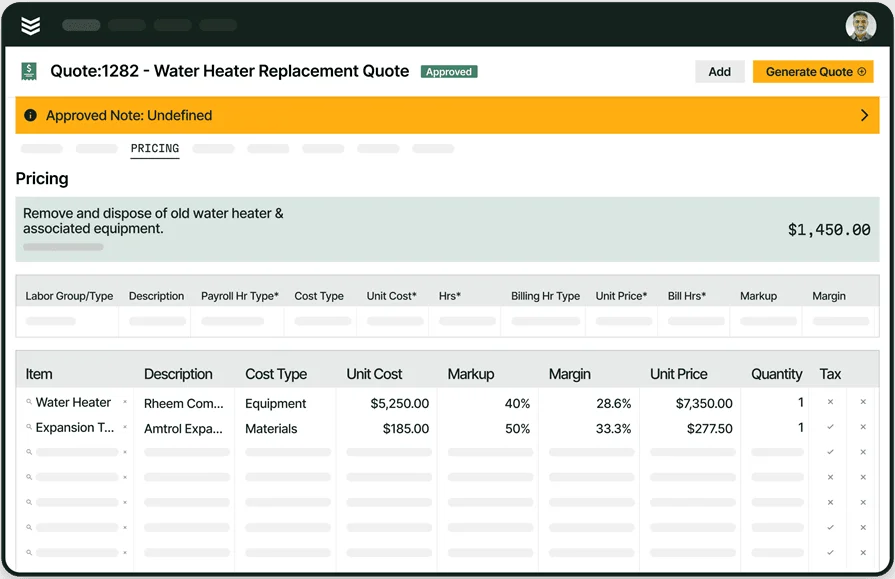
Explore our quoting product
Price jobs accurately so you save money and reduce payment friction.
10 steps to pricing plumbing work for your business
Good plumbing pricing doesn’t start with a number—it starts with a process. Every estimate you build should reflect real costs, protect your margins, and win the customer’s trust. Whether it’s a quick repair or a full system install, these steps walk you through the entire job lifecycle—from the first call to the final payment—so every quote is backed by logic, not guesswork.
1. Take the service call
Start strong by gathering job details—what’s wrong, where the job is, how urgent it is, and who’s paying. First impressions count, especially when pricing service calls. Using a field service booking software setup helps you log call data, customer info, and job type right from the start, giving you a cleaner handoff to the estimator or tech quoting the job.
2. Choose your pricing model
Not every job fits the same format. Simple fixes may work with flat rates, while exploratory repairs or large installations call for time and materials or project-based pricing. Base your model on the job type, urgency, and customer expectations. Whatever you choose, make sure your plumber pricing stays consistent across your team.
3. Scope out labor needs
Break the job down by how long it will take and who’s needed to do it. Are you sending a solo journeyman or a two-person team? Factor in setup, diagnostics, repair, and cleanup. You can streamline this step by using data from your field service ticketing system, which shows you average labor time by job type.
4. List out materials and parts
Itemize everything: fittings, fixtures, pipe, sealant—whatever the job requires. Refer to recent invoices or supplier price sheets to avoid underpricing. Standardizing your parts list also helps when pricing multiple bids or jobs in one go.
5. Factor in equipment
If you’re using specialty tools—jetters, pipe cameras, or threading machines—include their value. That includes rentals or wear-and-tear on owned tools. Tracking equipment usage inside a field service dashboard lets you see what gear is used often, how much time it adds, and how it should factor into cost recovery.
6. Add travel and access costs
Time spent getting to the site is still time on the clock. Account for traffic, parking, fuel, and mileage—especially if the job is far out or in a tough-to-access zone. Travel costs should never eat into your margin. Build this in upfront so your plumbing pricing reflects the real cost of doing business.
7. Account for risk or urgency
If it’s a same-day emergency or after-hours call, the price needs to reflect that. Premium time, quick scheduling, and extra prep all cost more. Use historical data from your plumbing field service metrics and KPIs to decide when to trigger emergency pricing and how much to increase it by.
8. Don’t forget overhead
Overhead is where many plumbers lose margin without realizing it. Shop rent, insurance, phones, admin, vehicle maintenance—these all need to be baked into your rates. Use a consistent overhead percentage in every quote to ensure you’re covering total operating costs—not just the labor and parts.
9. Finalize the quote and send it
Once everything’s calculated, build a clear, professional quote. Include job description, materials, labor, taxes, and terms. Using historical invoice data and tech performance from your field service reporting can help you fine-tune your quote format and eliminate common billing gaps.
10. Track performance and learn from it
After the job wraps and the invoice is paid, don’t forget the follow-up. Was the labor estimate accurate? Did you miss a cost? Review every job against its estimate and adjust your future pricing accordingly. Reviewing trends in your field service metrics helps identify where estimates break down and how to sharpen them moving forward.
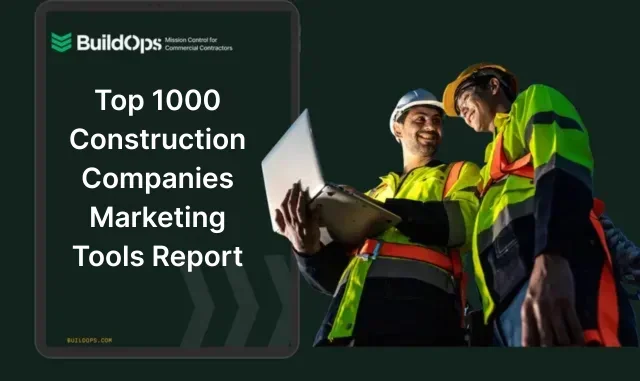
Land more plumbing jobs—faster
Find out how leading companies drive more leads and complete more jobs.
10 tips to achieve fair and competitive plumbing pricing
These best practices help contractors quote plumbing work with confidence. They’re based on what separates shops that run lean and profitable from those stuck undercharging or constantly reworking estimates. Whether you're quoting a water heater swap or a commercial buildout, these tips tighten up your process and protect your bottom line.
1. Review your rates on a set schedule
Your pricing shouldn’t stay the same while your costs go up. Set a time—monthly, quarterly, or after every material price increase—to review labor rates, supply costs, and travel expenses. This helps keep your plumbing pricing relevant and profitable instead of reactive or outdated.
2. Study your local market
You’re not quoting in a vacuum. Check what other plumbers in your region charge for similar services—especially emergency work, installs, or maintenance contracts. If you’re charging way more or less than the average, understand why and adjust accordingly. This helps you stay competitive without guessing.
3. Use job history to guide future quotes
Past jobs are your best pricing guide. Compare estimated vs. actual hours, material usage, and final billing totals. If you’re quoting similar work again, use what actually happened—not what you thought would happen. Tracking this through dispatch invoicing software gives you a real-world feedback loop that improves accuracy over time.
4. Break down every cost—no shortcuts
No one wants a vague quote. Make sure your estimates itemize every piece of the job—labor, parts, permits, disposal, even parking fees if needed. This transparency gives customers confidence and helps reduce change order disputes later on. It also makes your plumber pricing easier to explain and defend.
5. Keep markup consistent, not random
Guessing at markups leads to chaos. Set baseline percentages for labor and materials—then stick to them across your team. This ensures your jobs stay profitable, no matter who’s quoting. It also avoids inconsistencies that confuse customers or make your business look disorganized.
6. Avoid overpricing low-effort jobs
A ten-minute fix shouldn’t be priced like a full-day install. Overpricing small jobs can scare away easy wins or damage trust with regular clients. Know when to simplify the quote, and make sure your pricing plumbing jobs reflects the time and tools required—not just a padded flat rate.
7. Watch for hidden scope creep
A job that starts with a leak repair might turn into replacing a section of corroded pipe. That’s fine—as long as you stop, re-evaluate, and communicate the cost difference. Always document these changes and get approval before moving forward. It protects your margin and keeps customers from feeling blindsided.
8. Automate quoting wherever possible
If you're manually pricing every faucet install or water heater replacement, you're wasting time. Build templates for common jobs and use digital tools to fill in the rest. Solutions like scheduling and invoicing software make it easier to pull job info, add costs, and send professional quotes with just a few clicks.
9. Factor in your customer relationship
New clients might need a little extra explanation. Long-time customers might expect some flexibility. Use what you know about the person or business you’re quoting for—are they high-value, always pay on time, or frequently call for service? Having a CRM for plumbers helps you tailor your quotes and terms accordingly.
10. Walk through the quote with the customer
Sending a quote without context can lead to hesitation or confusion. Take a few minutes to explain it—whether on-site, over the phone, or via video call. Go over what’s included, how you calculated it, and where adjustments could be made if needed. That extra clarity often makes the difference between winning and losing the job. If you're using tools like a plumbing invoice template or building estimates through field service invoicing software, it also helps the customer understand you’re quoting based on structured, reliable info—not guesswork.
Getting your plumbing pricing right isn’t about finding the “perfect” number—it’s about having a system that backs up your quote every time. The most successful plumbing businesses aren’t winging it. They’ve built pricing strategies around repeatable processes, real data, and tools that help them scale without cutting corners.
Everything we’ve covered—from choosing the right pricing model to tracking how well your quotes hold up in the field—takes coordination across your team. That’s where all-in-one platforms come in. A solution like BuildOps connects estimating, dispatch, inventory, invoicing, and customer history into one unified workflow. Features like real-time quote tracking, field-ready pricing tools, and post-job performance data aren’t standard in most systems—but they’re built into the way BuildOps helps commercial contractors operate.
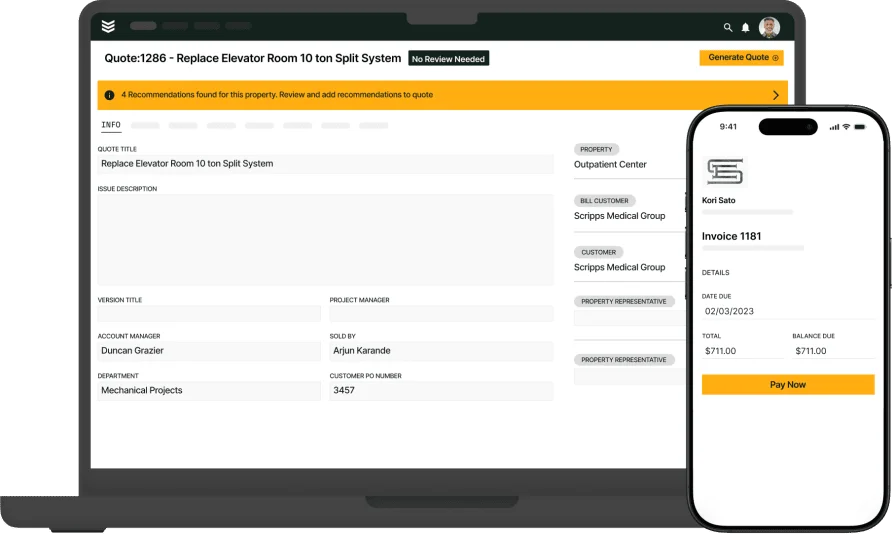
See what commercial pros love
Sharpen your pricing so you land more jobs and get paid on time—never late.
